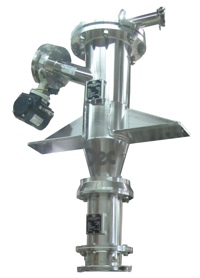Pharmaceutical and chemical plant explosions are industrial disasters with destructive consequences. Charging a reactor with dusty bulk materials is one of the main causes of explosions within the realms of powder handling. Reactors often contain solvents into which the reactants are added. The formation of an explosive atmosphere, which can build up with flammable solvent vapours and a dust/air mixture of the powder, together with a potential source of ignition, have in the past provoked violent explosions, ripping apart whole facilities.
Eliminate your risk with the PTS Powder Transfer System
The patented conveying PTS system developed by Dec is a highly effective method for transferring dry and moist powders. It transfers powder in dense-phase (plug flow), i.e. at low velocities, thus avoiding too much energy to form electrostatic discharge within the product. In terms of materials, it only uses conductive, grounded components, which eliminate further possible ignition sources.
Another benefit is that it isolates the receiving vessel during the powder charging process by separating the air from the powder thus keeping the reactor inert.
Operation mode
The PTS safely and automatically introduces explosive, toxic or any other kind of powder to pressurised vessels or to reactors that contain hazardous vapours. The system is installed directly onto the process equipment to be charged. By using vacuum, the powder gets drawn into the PTS pump body. The flat filtration membrane isolates the powder from entering into the vacuum line. When the chamber is filled, the product is discharged into the vessel by means of pressurised gas, often nitrogen or another inert gas. At the same time, the reverse flow of the gas cleans the membrane each time the product is discharged into the reactor reinstating optimal performance conditions for the next suction cycle. The overpressure in the chamber also prevents vapours that are present in the vessel from entering into the PTS body. The transfer rate is easily controlled by the pneumatic control panel.
Main benefits of the PTS Powder Transfer System
- Empties or fills all process equipment including reactors, dryers and centrifuges
- Transfers all powders regardless of their characteristics (sticky, fine, non-free flowing, hygroscopic, moist, etc.)
- Safely conveys toxic < 1µg/m³ or dust explosive powders < 1mJ
- Dense-phase transfer, synonym for no particle damage
- Charges directly into closed vessels under vacuum or pressure
- Prevents dust creation
- Eliminates oxygen from the powder before entering into the process
- Charges in the presence of solvents
- No product retention
- Total containment
- Easy to clean – CIP system
- Hygienic sterile units
Flexibility and capacity to handle manufacturing challenges
In addition to reactor charging, the PTS can be used in combination with a myriad of process equipment. As a major improvement to any process, whether it is a filling, discharging, blending or a dosing application, the PTS provides high containment where necessary, boosts production and improves safety. Production times can be reduced to a large extent and process steps can be linked to each other, saving time and money.
New developments for dosing applications

The DosiValve is the latest advance in the PTS product line
The most recent advance in the PTS product line consists of the integration of a new dosing unit, the DosiValve, into the PTS, eliminating the need for an intermediate receptacle like a buffer hopper between transferring and dosing. It allows the dosing of solids by means of a closing cone. This pneumatically driven piston opens and closes the passage according to the required parameters. By varying these settings, speed, weight and precision are controlled. With the optionally integrated fluidisation cone even sticky or moist powders are easily handled. Easy cleaning and sterilisation (CIP/SIP) is another significant benefit. The DosiValve is a low cost, efficient dosing system, which can be easily integrated into any process and effectively overcomes frequently encountered hurdles when handling and dosing difficult flowing powders.
In combination with a Continuous Liner System (CLS), transferring, accurately dosing and packaging powder and granules into bags becomes a fully integrated, automated production step for manufacturing units.
Any industry that handles powders should reflect on a safe and efficient handling solution. Important factors such as the reduction of manual handling, maintaining hygiene or the return on investment all require careful consideration.
For more information or to discuss your process containment and powder handling needs please contact DEC Group directly info@dec-group.ch
